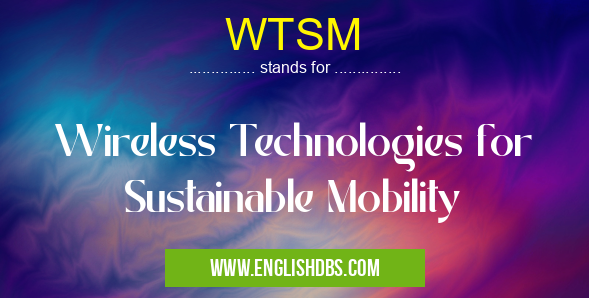What does WTSM mean in UNCLASSIFIED
WTSM stands for Wireless Technologies for Sustainable Mobility. It encompasses a comprehensive array of wireless communication and sensing technologies that enhance the safety, efficiency, and environmental friendliness of transportation systems. By leveraging wireless networks, vehicles, infrastructure, and users can seamlessly interact, sharing real-time data to optimize mobility and reduce emissions.

WTSM meaning in Unclassified in Miscellaneous
WTSM mostly used in an acronym Unclassified in Category Miscellaneous that means Wireless Technologies for Sustainable Mobility
Shorthand: WTSM,
Full Form: Wireless Technologies for Sustainable Mobility
For more information of "Wireless Technologies for Sustainable Mobility", see the section below.
# Introduction
Key Features of WTSM:
- Vehicle-to-Vehicle (V2V) Communication: Enables vehicles to exchange information about speed, location, and trajectory, improving road safety and traffic flow.
- Vehicle-to-Infrastructure (V2I) Communication: Connects vehicles to roadside infrastructure (e.g., traffic lights, sensors) to enhance situational awareness and optimize traffic management.
- Vehicle-to-Pedestrian (V2P) Communication: Alerts drivers and pedestrians to potential hazards, improving safety at crosswalks and intersections.
- Intelligent Transportation Systems (ITS): Integrates WTSM technologies with traffic management systems, providing real-time traffic information and optimizing routes for improved efficiency.
- Wireless Sensor Networks: Deploys sensors throughout the transportation network to monitor traffic patterns, detect incidents, and collect environmental data.
# Benefits of WTSM
- Improved Safety: Reduces road accidents by providing drivers with advance warning of hazards and improving situational awareness.
- Enhanced Efficiency: Optimizes traffic flow, reduces congestion, and lowers travel times.
- Reduced Emissions: Promotes the use of eco-friendly vehicles and reduces fuel consumption by optimizing routes and improving traffic management.
- User Convenience: Provides real-time traffic information, navigation assistance, and personalized mobility services.
- Economic Savings: Reduces costs associated with traffic congestion, accidents, and environmental damage.
# Conclusion
WTSM represents a transformative approach to sustainable mobility. By harnessing the power of wireless technologies, it empowers vehicles, infrastructure, and users to collaborate seamlessly, creating a safer, more efficient, and environmentally responsible transportation system. The adoption of WTSM technologies has the potential to revolutionize the transportation industry and contribute significantly to a more sustainable future.
Essential Questions and Answers on Wireless Technologies for Sustainable Mobility in "MISCELLANEOUS»UNFILED"
What is Wireless Technologies for Sustainable Mobility (WTSM)?
WTSM encompasses a range of wireless technologies, including 5G, Wi-Fi, and Bluetooth, that are deployed to optimize transportation systems for improved sustainability. By connecting vehicles, infrastructure, and people, WTSM aims to reduce emissions, enhance safety, and increase efficiency in the transportation sector.
How does WTSM contribute to reducing emissions?
WTSM technologies enable real-time traffic management and vehicle-to-vehicle (V2V) communication. These capabilities allow vehicles to optimize routes, reduce idling time, and adjust speeds based on traffic conditions. By reducing vehicle congestion and improving flow, WTSM contributes to lower emissions and improved air quality.
What are the safety benefits of WTSM?
WTSM technologies, such as V2V communication and vehicle-to-infrastructure (V2I) communication, provide real-time alerts and warnings to drivers. These systems can detect potential hazards, alert drivers to nearby emergency vehicles, and facilitate autonomous driving features. By enhancing situational awareness and reducing reaction times, WTSM improves road safety and reduces the risk of accidents.
How does WTSM increase transportation efficiency?
WTSM technologies enable smart traffic management systems that optimize traffic flow, reduce congestion, and improve coordination between different modes of transportation. By reducing travel times, WTSM improves the efficiency of transportation systems, saves fuel, and reduces operating costs.
What are some specific examples of WTSM technologies?
WTSM includes a wide range of technologies, such as:
- 5G networks for high-speed data transmission and low latency
- Wi-Fi for connectivity between vehicles and roadside infrastructure
- Bluetooth for short-range communication and device pairing
- V2V communication for vehicle-to-vehicle data exchange
- V2I communication for vehicle-to-infrastructure data exchange
- GPS and inertial sensors for vehicle positioning and navigation
